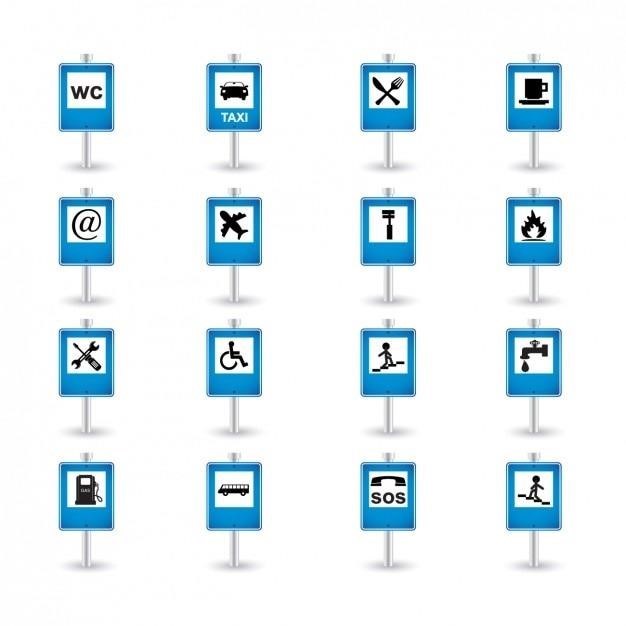Mandatory Instruction Signs⁚ An Overview
Mandatory instruction signs communicate crucial directives, ensuring adherence to safety regulations and operational procedures. These signs, often featuring a red background with white lettering, are vital for guiding actions in various environments, from airports to workplaces.
Types of Mandatory Instruction Signs
Mandatory instruction signs encompass a broad range of directives, categorized by their specific application and purpose. Airport signage, for instance, includes runway holding position signs, crucial for safe aircraft operation and preventing collisions. These signs often use a standardized color scheme and symbol system for immediate understanding. Workplace safety signs, conversely, focus on employee protection, dictating mandatory actions like wearing protective gear or following specific procedures to prevent accidents. These are usually more concise and direct, utilizing clear symbols and text. Other types might include traffic control signs in public areas, indicating mandatory directions or actions for pedestrians and vehicles. The design and wording vary based on the context, ensuring the information is easily interpreted.
Airport Mandatory Instruction Signs
Airport mandatory instruction signs are critical for maintaining safety and efficiency within the complex environment of an airport. These signs utilize a standardized system of colors, symbols, and wording to convey essential instructions to pilots, ground crews, and other personnel. Examples include runway holding position signs, which clearly indicate where aircraft must stop before proceeding onto a runway. Signs denoting entrances to runways or restricted areas are also crucial for preventing unauthorized access and maintaining separation between aircraft and ground vehicles. The design and placement of these signs are carefully regulated to ensure maximum visibility and understanding, even under challenging conditions such as low visibility or inclement weather. Clear communication is paramount to preventing accidents and delays.
Workplace Mandatory Safety Signs
Workplace mandatory safety signs are essential for ensuring a safe and healthy work environment. These signs communicate critical safety procedures and requirements using clear and concise instructions, often accompanied by easily understood symbols. They mandate specific actions that employees must take to mitigate risks and prevent accidents. Examples include signs requiring the use of personal protective equipment (PPE), such as safety glasses or hard hats, or those outlining emergency procedures in case of fire or other hazards. Compliance with these signs is not optional; they are legally mandated to protect workers from potential harm. Effective placement and design are crucial for ensuring visibility and comprehension, minimizing the chance of misinterpretation and promoting a culture of safety within the workplace. Regular inspections and maintenance are necessary to ensure that these signs remain legible and effective.
Design and Characteristics of Mandatory Instruction Signs
Effective mandatory instruction signs utilize clear, concise wording and easily recognizable symbols. Standardized color schemes, such as red backgrounds for mandatory instructions, enhance visibility and immediate comprehension.
Color Schemes and Symbolism
Color plays a crucial role in the effectiveness of mandatory instruction signs. Internationally recognized standards often utilize a red background for mandatory instructions, immediately conveying the imperative nature of the message. This high visibility color ensures the sign’s message is quickly and easily understood, even from a distance or in low-light conditions. The use of contrasting colors, such as white or yellow lettering on a red background, further enhances readability and clarity. Beyond color, standardized symbols are frequently incorporated to enhance comprehension, particularly for individuals who may not understand the written language or have language barriers. These symbols act as universal visual cues, providing immediate understanding of the required action or procedure. The combination of color and universally understood pictograms makes the signs more accessible and easier to comprehend across diverse audiences, leading to improved safety and compliance. Careful selection of both color and symbolism is essential for effective communication and minimizing misinterpretations, thereby ensuring the intended message is clearly conveyed and followed.
Wording and Clarity
The wording on mandatory instruction signs must be concise, unambiguous, and easily understood. Complex sentences or jargon should be avoided; instead, clear and direct language is paramount. The use of imperative verbs, such as “Stop,” “Wear,” or “Yield,” clearly indicates the required action. Font size and style are also critical considerations; large, bold lettering ensures readability from a distance, even under challenging visibility conditions. Furthermore, the choice of language should consider the target audience. In multilingual environments, multiple languages may be necessary to ensure universal comprehension. Careful consideration must be given to the cultural context and literacy levels of the intended audience to ensure effective communication. The overall goal is to deliver the message instantly and unequivocally, leaving no room for misinterpretation or delay in response. Any ambiguity can lead to non-compliance and potentially hazardous situations.
Placement and Visibility
Strategic placement is crucial for the effectiveness of mandatory instruction signs. Signs should be positioned where they are easily visible to those they are intended to reach, avoiding obstructions or areas of poor lighting. Line of sight is a key factor; signs should be located where they are readily seen before the relevant action point. For example, a “Stop” sign should precede a potential hazard. Consideration should also be given to the height of placement; signs must be easily visible to individuals of varying statures, both standing and seated. In high-traffic or busy areas, multiple signs may be required to ensure visibility from multiple angles and perspectives. The use of high-visibility materials, such as reflective sheeting, can significantly enhance visibility in low-light or nighttime conditions. Regular maintenance and cleaning are essential to ensure signs remain legible and free from damage, maintaining their effectiveness in conveying essential safety information.

Legal and Regulatory Aspects
Compliance with safety standards is paramount. International regulations and local laws govern the design, placement, and usage of mandatory instruction signs, dictating penalties for non-compliance.
Compliance with Safety Standards
Adherence to established safety standards is crucial for mandatory instruction signs. These standards dictate the precise design elements, including color schemes, symbol usage, and wording clarity, to ensure effective communication. Regulations often specify the materials used in sign construction, guaranteeing durability and visibility under diverse conditions. For instance, airport signage must meet stringent standards for readability from significant distances, even in low-light situations or inclement weather. Workplace safety signs, likewise, need to be easily understood and readily visible, even amidst potential distractions. Regular inspections and maintenance are essential to guarantee signs remain compliant and effective in preventing accidents and promoting safety. Failure to comply with these standards can result in hefty fines or legal repercussions, highlighting the importance of prioritizing safety regulations.
International Regulations
International harmonization of mandatory instruction sign standards is pursued to facilitate understanding across borders. Organizations like the International Civil Aviation Organization (ICAO) establish guidelines for airport signage, ensuring consistent interpretation globally. These regulations cover aspects like symbol standardization, color coding, and placement to minimize confusion for travelers and personnel navigating international airports. While national regulations may exist alongside international standards, the goal is to create a universally recognized system. This reduces the potential for misinterpretations, which can have significant safety implications. The development and enforcement of these international regulations are ongoing processes, continually refined to reflect best practices and technological advancements in communication and signage technology.
Enforcement and Penalties
Enforcement of mandatory instruction sign regulations varies depending on the jurisdiction and the specific context. In aviation, regulatory bodies like the Federal Aviation Administration (FAA) in the United States and equivalent agencies worldwide are responsible for overseeing compliance. Non-compliance can result in significant penalties, including hefty fines and potential operational restrictions for airports or airlines. Workplace safety regulations are often enforced by occupational safety and health agencies, with penalties ranging from warnings and citations to legal action for serious violations. The severity of penalties often reflects the potential consequences of disregarding the signs, with those related to significant safety risks incurring stricter enforcement and more severe punishments. Consistent monitoring and effective enforcement mechanisms are crucial to maintaining safety standards and ensuring the effectiveness of mandatory instruction signs.

Examples of Mandatory Instruction Signs
Runway holding position signs, clearly marked safety procedures within workplaces, and “Wear eye protection” signs illustrate mandatory instruction signage.
Runway Holding Position Signs
Runway holding position signs are paramount for air safety. These mandatory instruction signs, typically featuring a red background with white lettering and a bold “HOLD” inscription, are strategically placed at runway intersections and entrances. Their purpose is to prevent aircraft from inadvertently entering active runways, thereby averting potential collisions and ensuring the smooth flow of air traffic. These signs are not merely suggestions; they represent legally binding instructions that pilots must obey. Failure to comply can result in serious consequences, including sanctions from aviation authorities. The design of these signs is standardized internationally to ensure clear and unambiguous communication across different airports and jurisdictions. Their placement is carefully planned to offer optimal visibility to pilots under various weather conditions and lighting situations. The effectiveness of runway holding position signs depends on their high visibility, clear messaging, and consistent enforcement. They are a critical component of a comprehensive airport safety management system.
Safety Procedures in Specific Workplaces
Mandatory instruction signs play a crucial role in maintaining workplace safety across diverse industries. Construction sites utilize signs mandating hard hat use, eye protection, and adherence to specific fall prevention protocols. Manufacturing plants might feature signs detailing lockout/tagout procedures for machinery, emphasizing the critical need to de-energize equipment before maintenance. Hospitals employ signs indicating proper hand hygiene and the use of personal protective equipment (PPE) to prevent infection transmission. These signs are not merely informative; they establish legally mandated safety procedures. Non-compliance can lead to disciplinary action, and in severe cases, legal repercussions. Effective mandatory instruction signs in the workplace rely on clear, concise language, easily understood symbols, and prominent placement in high-visibility areas. Regular audits and employee training are essential to ensure understanding and compliance with the safety procedures outlined in these signs, thereby fostering a safer work environment for everyone.
